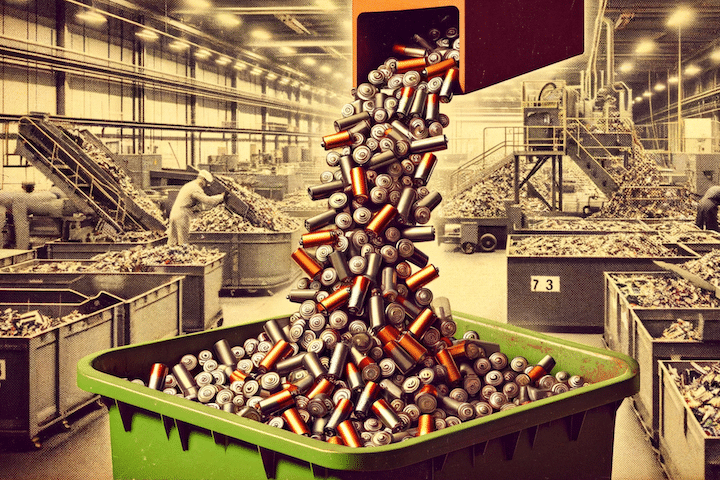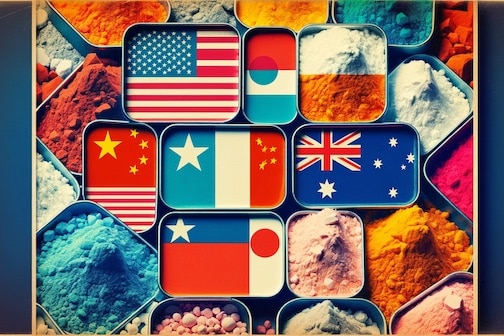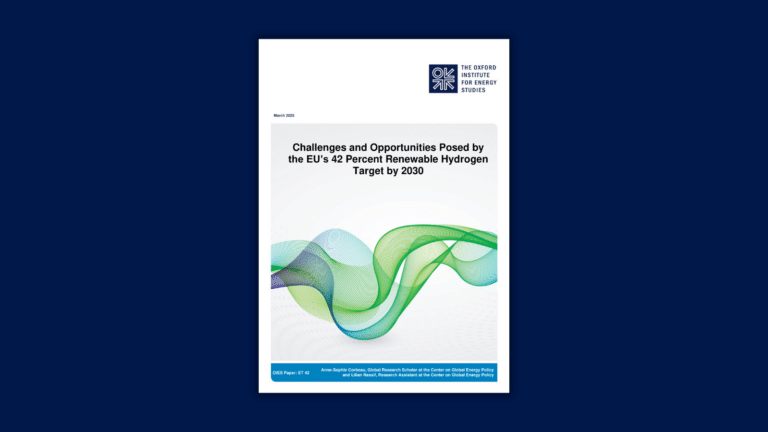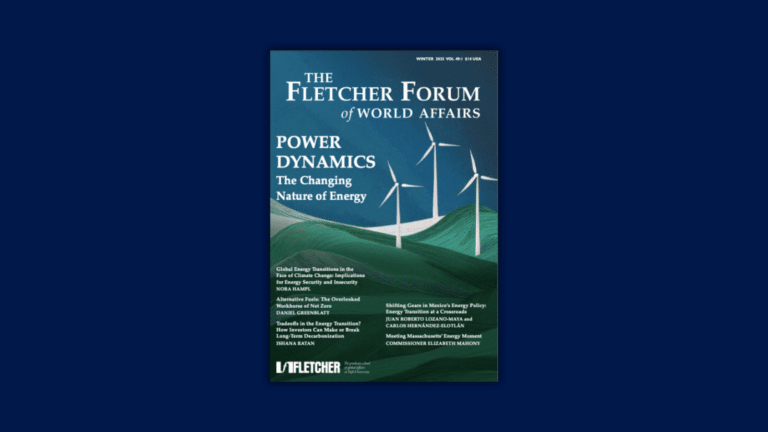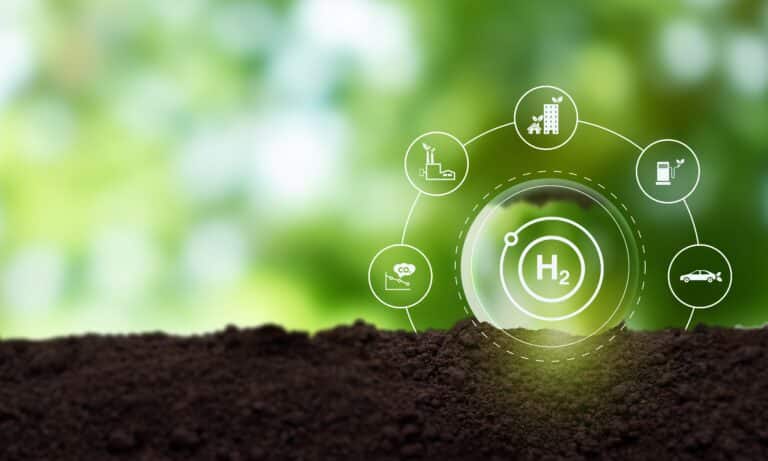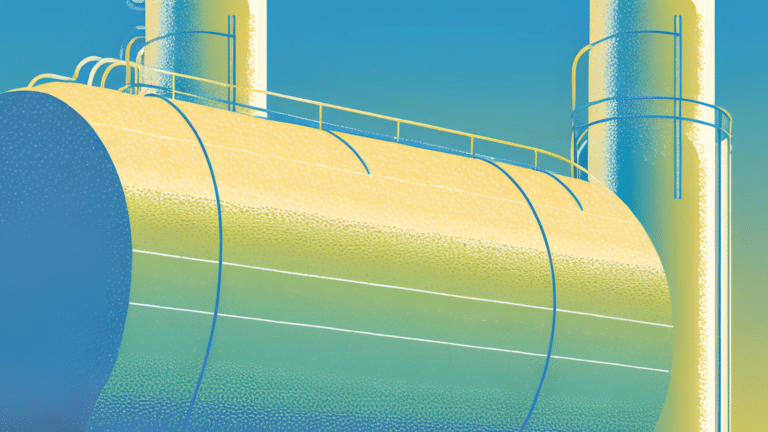Melissa Lott: [00:00:00] So we just went through all of our episodes and counted the number of times that we’ve mentioned the word hydrogen on this show. And we came up with 95, 95 times that we’ve mentioned this fuel that a lot of people don’t really understand. So I think it’s time that we explain it, especially because there’s a ton of hype around hydrogen these days. When you start Googling the word hydrogen, you’ll find something funny. It comes in a whole rainbow of colors. Not all hydrogen is created equal. [00:00:30][30.3]
Unidentified speakers: [00:00:30] Will you believe it that there is pink hydrogen? There’s yellow. Hydrogen. But have you heard about blue or green hydrogen? So when did hydrogen go green? [00:00:37][7.1]
Melissa Lott: [00:00:41] So what’s happening here? How did hydrogen end up coming in a rainbow of colors? To find out, we talked to a very musical hydrogen expert. [00:00:49][7.7]
Julio Friedman: [00:00:50] When I think about the hydrogen rainbow, there’s pink and blue and green and yellow, brown and gray and turquoise, too. The only question you should ask is, is it clean for me and you? So we don’t want to get bogged down in the colors because the color colors become like lingo. It’s more important to think, Is it clean? [00:01:07][17.6]
Melissa Lott: [00:01:09] Is it clean? That’s the question that matters. And it really, really matters. If it’s clean and free of carbon pollution, then hydrogen has the potential to become an incredibly important part of the net zero economy. [00:01:21][11.8]
Julio Friedman: [00:01:22] Hydrogen is the Swiss Army knife of decarbonizing things. It can be applied in many sectors in many ways. [00:01:28][5.9]
Melissa Lott: [00:01:28] But if the hydrogen is made with lots of carbon pollution, like most of it is today, it doesn’t do us a lot of good. So today, what exactly is hydrogen? What can make it the Swiss Army knife of decarbonizing things? And what’s up with all the colors? This is the big switch show about how to rebuild the energy systems that are all around us. I’m Dr. Melissa Lott, and I’m the director of research at Columbia University’s Center on Global Energy Policy. All right. Before we get to the colors, why hydrogen at all? When you think about the energy transition, we usually think about renewables and batteries and electrification. And those are all really, really important. But there are all these difficult parts of the economy that are really hard to decarbonize that way. Those sticky parts of the economy, that’s where we might see hydrogen come in. [00:02:17][48.9]
Julio Friedman: [00:02:20] For me, the killer app is heavy industry. It is things like steel and the chemical sector and plastics and fertilizer and cement and glass. [00:02:30][10.7]
Melissa Lott: [00:02:31] Remember from the very top of the show, that guy who was saying that hydrogen is like the Swiss Army knife for decarbonizing things. Well, that’s Dr. Julio Friedman and he’s the chief scientist at a company called Carbon Direct. He used to lead research on carbon management at Columbia Center on Global Energy Policy, where I work. And he thinks a lot about hydrogen. So where could we use the Swiss Army knife? Let’s start with heavy industry. [00:02:53][21.4]
Julio Friedman: [00:02:54] It burns hot and I mean really hot, like 4000 degrees Fahrenheit hot. You can melt rocks by burning hydrogen. So that means you can use it to melt glass. You can use it to make steel. You can use it to make concrete. The second place we’re going to use a lot of hydrogen is in heavy duty transport, mostly trucks, trains and ships. So you can put a battery in a van. It is much harder to put batteries in a thousand mile truck trip. It is even harder to put it in a 10,000 mile boat trip. So hydrogen ends up being something you can turn into a fuel or use directly to move really heavy stuff when you need a lot of energy and you need to go a long distance. Another place we think we might use, hydrogen is in planes. Hydrogen has the advantage of being very light because it is very light. It’s a good fuel for a plane. And then finally, we can use it to make electricity. So you can store it as a fuel for the power sector. It can be great long duration storage. You can store hydrogen for weeks or months or years and pull it out whenever you needed to make electricity. [00:04:04][70.0]
Melissa Lott: [00:04:08] You can also use it to hit your home and you can use it to make fuel and fertilizer. A whole bunch of things. Swiss Army knife. Right. So what’s the catch? Why don’t we just make a whole bunch of this stuff and hooray! Decarbonize everything. So. Okay. Remember when Julia was thinking about all the colors of hydrogen? That’s the problem. Some colors are good and some, well, they aren’t so hot, so let’s get into it. It’s rainbow time. [00:04:33][25.2]
Julio Friedman: [00:04:36] For me, the most important colors are gray, blue, green and bio. And bio is not a color, but it’s category that’s important. [00:04:45][8.6]
Melissa Lott: [00:04:46] We’re going to talk about each one of these colors and we’re going to start with the one that we make the most of right now. That one is also, unfortunately, the dirtiest part of the rainbow. Appropriately, it’s the color gray. Gray. [00:04:57][11.0]
Julio Friedman: [00:05:00] So gray. Hydrogen is how we do it today. In almost everywhere in the world, all of the hydrogen we make is made by taking a fossil fuel like methane, taking the hydrogen off of that methane. When you do that, you make carbon. It means you’re not managing the carbon emissions. [00:05:16][16.1]
Melissa Lott: [00:05:17] So basically, when we make great hydrogen, we produce a lot of carbon pollution that gets released into the atmosphere, which isn’t great. Next up, blue. Blue. [00:05:25][8.3]
Julio Friedman: [00:05:28] Blue is basically the same thing, but you are managing the carbon emissions and you can just capture the byproduct CO2 and store it underground forever. [00:05:37][9.4]
Melissa Lott: [00:05:38] Okay, so we have gray, hydrogen, gray. But if you capture that CO2 with carbon capture and storage, a.k.a. CCS, it becomes blue, hydrogen, blue. [00:05:48][9.8]
Julio Friedman: [00:05:50] If you do that, it can be very clean. There are things you need to watch out for, like the associated emissions. If you’re using natural gas, there can be upstream leakage of natural gas, which is quite bad. [00:06:01][11.7]
Melissa Lott: [00:06:02] The key thing is that you have to capture the emissions and that’s not always easy to do. But if there’s an effective regulation and accurate measurement of carbon emissions, well then you can theoretically capture most of the carbon emissions using CSE. But we still haven’t proven that CCS can work at the scale that we need for massive hydrogen production. Next up is a category that, well, isn’t really a color. It’s bio four. Bio hydrogen. Bio hydrogen, as you heard at the top of the show. And Coolio is excited about something. He really likes to explain it in a song. [00:06:34][32.6]
Julio Friedman: [00:06:35] We have a Sesame Street vibe here going to do so. Lily Oh, I love trash. Anything dirty or dingy or dusty? [00:06:45][9.9]
Melissa Lott: [00:06:46] This is the kind of hydrogen that Oscar the Grouch would love, because, yes, you can actually make hydrogen out of trash. [00:06:52][6.3]
Julio Friedman: [00:06:53] You can turn municipal solid waste into hydrogen. Most people don’t know that, but you can. So this goes into a machine called the gasifier. The gasifier turns solids into gases, and trash is basically carbon, hydrogen and oxygen. So it turns it into those gases. Then you put it through a chemical transition that separates the hydrogen from the other stuff. Now, if you start with trash that is already carbon neutral. [00:07:20][27.2]
Melissa Lott: [00:07:21] It’s carbon neutral because the greenhouse gases from that trash would have been emitted anyway as the trash decomposed surface end up separating out the hydrogen byproduct. And the argument is that you’re not actually adding to emissions at all. It’s neutral. You get a similar effect. If instead of trash, you start with agricultural waste or wood waste. [00:07:39][18.0]
Julio Friedman: [00:07:40] Now, you do have that byproduct CO2. So if you take that CO2 and store it underground, then in fact what you’re doing is not only cleaning up a landfill, but you’re cleaning up the air and oceans, you’re pulling that CO2 and you’re putting it in the lock up forever. [00:07:54][13.6]
Melissa Lott: [00:07:58] All right, let’s recap. We’ve got gray, gray, blue. And bio bio hydrogen. But even better is green hydrogen. [00:08:09][10.8]
Julio Friedman: [00:08:09] Green, green hydrogen is your high school chemistry class where you put electricity into water and you separate hydrogen and oxygen. And essentially you can do that with two wires. But it’s a lot better to use a device called an electrolyzer, which is basically a way to put a lot of electricity and a lot of water and separate the hydrogen and oxygen that way. That is green. Now, for it to be clean, you also have to worry about the upstream emissions, mostly the footprint of the electricity. So if you use U.S. power grid today, on average, it is way dirtier than gray hydrogen. But if you use 100% renewable power or 100% hydropower or 100% nuclear power, then it is born clean. [00:08:59][49.3]
Melissa Lott: [00:08:59] Or as Hulu likes to sing it. Born green. [00:09:02][2.4]
Julio Friedman: [00:09:03] Born green. Green as a frog. [00:09:06][3.5]
Melissa Lott: [00:09:08] You got gray, blue, bio and green. And there’s also a ton more like pink from nuclear and turquoise from splitting methane. It really high temperatures. But green using green power to split water. It’s so simple, so elegant. It’s so zero carbon. So why don’t we just make lots of it right now? [00:09:27][18.9]
Julio Friedman: [00:09:30] Bottom line is, it’s not easy being green. Making the hydrogen super green is super hard. You need a lot of energy and it costs a lot of money. That’s getting better. It’s getting better every day. But today, that’s the challenge. [00:09:43][12.4]
Melissa Lott: [00:09:43] Right now, blue and green hydrogen are the top contenders to replace dirty gray hydrogen. But green hydrogen requires tons of electricity to make, whereas blue hydrogen doesn’t require much electricity and is cheaper to make. [00:09:55][11.9]
Julio Friedman: [00:09:56] So right now, the most important ways to make clean hydrogen are blue and green. And we’re kind of in a horse race right now where blue has the lead on price in most places in the world. And also you can make it big in most places in the world. That is changing very fast. Green is coming on strong. So today, mostly we could do a lot of blue with a tiny bit of green. In 2050, it’ll be the opposite. It will be lots and lots of green hydrogen and a little bit of blue. And those two are key. And to keep living with us in our big switch world, because some markets are going to be really hard to do green and some markets are going to be really hard to do blue. And so even in a globally traded commodity set, something’s going to be better in one market versus another. We’re probably going to have a lot of blue and green as far as we can see. But if I had to place my bets and put my money on green on the long haul. [00:10:53][57.1]
Melissa Lott: [00:10:56] Coolio thinks that if we can fix a lot of hydrogen’s issues, then we could end up using a lot of hydrogen in the future. [00:11:02][6.0]
Julio Friedman: [00:11:03] The phrase to keep in your mind bonkers, huge amounts. So today we make about 70 or 80 million tonnes of hydrogen a year. Almost all of that is gray hydrogen. So. If we are going to make this transition, we need something more like 540 million tons a year. So we need like eight times more by 2050 if we’re going to do that. So that only gives us about 30 years to make that shift. But it’s much harder than that because today we’re making less than 0.2% of that hydrogen from green and we’re making less than 1% blue. So what we’re really talking about is increasing the amount of clean hydrogen we make by a factor of 400 or 500 times. To give you a sense of like how much energy this needs, if you just wanted to heat the homes in the state of New York with clean hydrogen made from green power, you need to triple the electric grid of New York. And that’s just for the homes. If you want to actually do the cement plants and the refineries and everything else, the boats, the cars, the trucks, it becomes an enormous number. [00:12:21][77.4]
Melissa Lott: [00:12:23] There’s a lot of debate on exactly how much hydrogen we might use in the future. But it seems really clear that if we want to use more hydrogen, then there’s a lot of work that we need to do. So what’s it going to take to make green hydrogen for the long haul? The first big challenge is electricity. When we make green hydrogen, we use a lot of zero carbon electricity to split those water molecules into oxygen and hydrogen. And more clean electricity means building more transmission lines and power plants. The really big equipment that makes the grid work. The other big challenge, no matter the color, is transporting hydrogen. [00:12:56][33.5]
Julio Friedman: [00:12:58] You don’t want to have to build a whole new pipeline network to move hydrogen around. It’s prohibitively expensive and will take forever. [00:13:05][7.0]
Melissa Lott: [00:13:05] What we really want to be able to do is use hydrogen in a similar way to how we use natural gas. Today, natural gas has moved around using an immense and sprawling network of pipelines and storage facilities located in much of the world. And when you look at a map of those natural gas pipelines, they look kind of like spiderwebs. But when you’re transporting gases, whether it’s natural gas or hydrogen around in these pipelines, you really have to keep an eye out for leaks. Hydrogen molecules are much, much smaller than natural gas molecules, and it’s sneaky and small and can escape and little gaps in the equipment. So we’d have to retrofit that infrastructure or build a whole bunch of hydrogen specific pipes in tanks. Or you could ship hydrogen around in trucks. But that’s not super efficient and it can be really expensive. But there’s another way. [00:13:48][42.8]
Julio Friedman: [00:13:52] The other way you move it is not as hydrogen. You move it as something else. And here what seems to be winning this race is ammonia. Ammonia? Say it loud and proud. Talk to me about ammonia. People do not understand what ammonia is. But this is coming your way, folks. It is going to be a big deal in our world. [00:14:14][21.4]
Melissa Lott: [00:14:14] So when you say ammonia, I think about cleaning my house. So I think about it. [00:14:18][4.1]
Julio Friedman: [00:14:19] So the way that I find it helpful to think about ammonia is in terms of how you use it and how you store it and how you move it around. It is a lot like propane. It’s the basically the same pressure and temperature constraints as propane. But what that means is like propane in a room, it’s a gas next to your cook stove. It’s a liquid. And so we store ammonia as a liquid that gives it very high energy density. So you’re able to put a lot of energy into a small volume and move it around this capability. This aspect of ammonia makes it a brilliant shipping fuel because you can put it on a ship and you can move it wherever you need to move. [00:15:05][46.7]
Melissa Lott: [00:15:06] By turning hydrogen into ammonia. We can more easily move this fuel around the world and then you can use it directly as ammonia, or you can split the hydrogen from the nitrogen. And the news that hydrogen as a fuel on its own. They could make a pretty good duo. Hydrogen pneumonia. So we’ve got three big issues. First, building enough renewables and nuclear to make enough green hydrogen. And second, building out the power grid infrastructure that’s needed to handle all of that electricity. And finally, transporting and storing those tiny little hydrogen molecules. And a lot of them. So how much money would it take to solve these issues if Julio’s right about the amount of hydrogen that we need in the future? Then he has a number for you and it’s $16 trillion trillion with a T. [00:15:56][49.4]
Julio Friedman: [00:15:56] So at today’s prices, we think we need 450 million tons a year of clean hydrogen. Just the infrastructure for that. The renewable power generation, the new power lines, the electrolyzers are $16 trillion. Even if the cost of that comes down because we have cheaper renewables and cheaper electrolyzers, we’re still talking about $10 trillion and that $10 trillion will be enough to get a big bite out of steel and a big bite out of chemicals and most just shipping. And even then, it’s still not everything. [00:16:32][35.5]
Melissa Lott: [00:16:33] How should we be thinking about the role of government and what can governments do in terms of supporting increasing the supply of the green hydrogen, the blue hydrogen, any type of hydrogen that gets us to net zero, really? [00:16:45][12.0]
Julio Friedman: [00:16:46] So there’s three ways the government does stuff. They spend money. They hand out lollipops or they whack people with sticks. That’s the mix. So the first thing the government could do is start buying clean hydrogen and a great place where they might think about doing this is actually buying clean hydrogen for fertilizers that they can use for farmers. They could also buy clean hydrogen as a fuel for ammonia and then like run the Coast Guard on ammonia. Like, these are things that they could actually do to get things kickstarted that creates supply chains and businesses get paid and people go to work. And that’s all good. The second thing that the government could do is hand out lollipops. These are basically subsidies or incentives. [00:17:32][46.1]
Melissa Lott: [00:17:33] Just pausing for a second here. We have tons of solar panels and wind turbines popping up across the world. That renewable energy is now outcompeting coal and in some places even outcompeting natural gas. But those renewables industries, including in the U.S., started with subsidies from governments. And that’s what Pouliot suggesting here. [00:17:52][19.0]
Julio Friedman: [00:17:53] And in fact, there’s a policy right now under consideration in Congress which would create effectively a production tax credit for clean hydrogen. And then the last way would be regulation. If we wanted to, we could just say, hey, all you hydrogen producers, by 2035, you have to have zero emissions. [00:18:10][17.7]
Melissa Lott: [00:18:11] All right. So let’s step back here and take stock. What exactly is hydrogen? Hydrogen is a gas that could be the Swiss Army knife for decarbonizing things, industry, heavy transportation, heating, even burning it to generate electricity. Hydrogen can store energy for days, weeks, even months. But the challenge is that it comes in a whole rainbow of colors. And some of those colors come with carbon emissions. A green hydrogen that comes from 100% carbon free electricity. And we want to make green hydrogen. But green is hard. Why? Because we might need a lot of hydrogen in the future. And scaling up will require a lot of cheap electricity, way more electricity, infrastructure and ways to transport and store the hydrogen. So we might need help from government to jumpstart this industry, just like it did with solar and wind power. And that’s our show. Next up on the Big Switch, how do we decarbonize buildings? The big switch is produced by Columbia University’s Center on Global Energy Policy in partnership with Post-Script Media. This episode was produced by Diana Waldorf and Alexandria Herr and story editing was by Ann Bailey, Mixing and Scoring by Sean Markland and Greg Bill Frank. Theme Music by Sean Marquand. A special thanks to our Columbia team Kirsten Smith, Cully, Liz Smith and Natalie Volk. Our managing producer is Cecily Meza martinez. And our executive editor is Steven Lacy. And another special thanks to the star of our show. [00:19:44][93.1]
Julio Friedman: [00:19:45] Why are there so many songs about rainbows? [00:19:49][3.7]
Melissa Lott: [00:19:50] This is the perfect way to spend on Wednesday afternoon. Okay. I’m Dr. Melissa Lott, and this is the big switch. [00:19:50][0.0]
[1120.8]



